Ahmet Üstün
Command A: An Enterprise-Ready Large Language Model
Apr 01, 2025Abstract:In this report we describe the development of Command A, a powerful large language model purpose-built to excel at real-world enterprise use cases. Command A is an agent-optimised and multilingual-capable model, with support for 23 languages of global business, and a novel hybrid architecture balancing efficiency with top of the range performance. It offers best-in-class Retrieval Augmented Generation (RAG) capabilities with grounding and tool use to automate sophisticated business processes. These abilities are achieved through a decentralised training approach, including self-refinement algorithms and model merging techniques. We also include results for Command R7B which shares capability and architectural similarities to Command A. Weights for both models have been released for research purposes. This technical report details our original training pipeline and presents an extensive evaluation of our models across a suite of enterprise-relevant tasks and public benchmarks, demonstrating excellent performance and efficiency.
When Personalization Meets Reality: A Multi-Faceted Analysis of Personalized Preference Learning
Feb 26, 2025Abstract:While Reinforcement Learning from Human Feedback (RLHF) is widely used to align Large Language Models (LLMs) with human preferences, it typically assumes homogeneous preferences across users, overlooking diverse human values and minority viewpoints. Although personalized preference learning addresses this by tailoring separate preferences for individual users, the field lacks standardized methods to assess its effectiveness. We present a multi-faceted evaluation framework that measures not only performance but also fairness, unintended effects, and adaptability across varying levels of preference divergence. Through extensive experiments comparing eight personalization methods across three preference datasets, we demonstrate that performance differences between methods could reach 36% when users strongly disagree, and personalization can introduce up to 20% safety misalignment. These findings highlight the critical need for holistic evaluation approaches to advance the development of more effective and inclusive preference learning systems.
If You Can't Use Them, Recycle Them: Optimizing Merging at Scale Mitigates Performance Tradeoffs
Dec 05, 2024
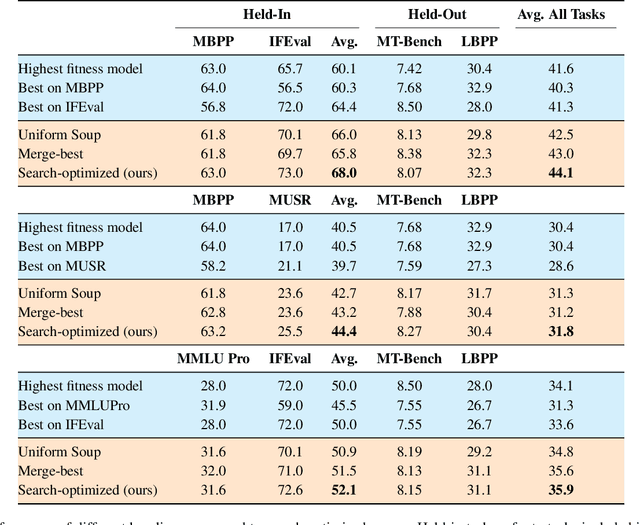
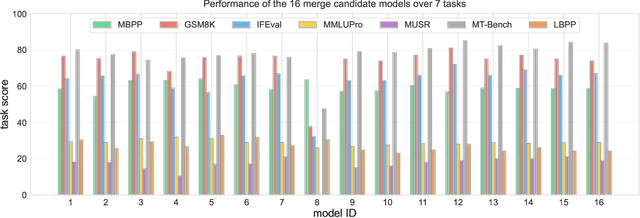
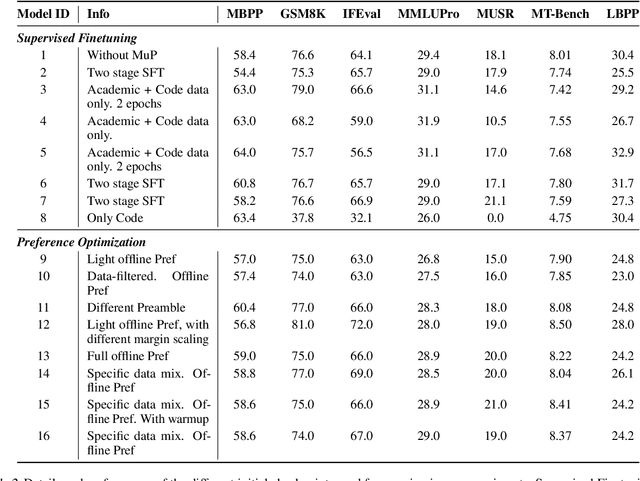
Abstract:Model merging has shown great promise at combining expert models, but the benefit of merging is unclear when merging ``generalist'' models trained on many tasks. We explore merging in the context of large ($\sim100$B) models, by \textit{recycling} checkpoints that exhibit tradeoffs among different tasks. Such checkpoints are often created in the process of developing a frontier model, and many suboptimal ones are usually discarded. Given a pool of model checkpoints obtained from different training runs (e.g., different stages, objectives, hyperparameters, and data mixtures), which naturally show tradeoffs across different language capabilities (e.g., instruction following vs. code generation), we investigate whether merging can recycle such suboptimal models into a Pareto-optimal one. Our optimization algorithm tunes the weight of each checkpoint in a linear combination, resulting in a Pareto-optimal models that outperforms both individual models and merge-based baselines. Further analysis shows that good merges tend to include almost all checkpoints with with non-zero weights, indicating that even seemingly bad initial checkpoints can contribute to good final merges.
Aya Expanse: Combining Research Breakthroughs for a New Multilingual Frontier
Dec 05, 2024



Abstract:We introduce the Aya Expanse model family, a new generation of 8B and 32B parameter multilingual language models, aiming to address the critical challenge of developing highly performant multilingual models that match or surpass the capabilities of monolingual models. By leveraging several years of research at Cohere For AI and Cohere, including advancements in data arbitrage, multilingual preference training, and model merging, Aya Expanse sets a new state-of-the-art in multilingual performance. Our evaluations on the Arena-Hard-Auto dataset, translated into 23 languages, demonstrate that Aya Expanse 8B and 32B outperform leading open-weight models in their respective parameter classes, including Gemma 2, Qwen 2.5, and Llama 3.1, achieving up to a 76.6% win-rate. Notably, Aya Expanse 32B outperforms Llama 3.1 70B, a model with twice as many parameters, achieving a 54.0% win-rate. In this short technical report, we present extended evaluation results for the Aya Expanse model family and release their open-weights, together with a new multilingual evaluation dataset m-ArenaHard.
Nexus: Specialization meets Adaptability for Efficiently Training Mixture of Experts
Aug 28, 2024



Abstract:Efficiency, specialization, and adaptability to new data distributions are qualities that are hard to combine in current Large Language Models. The Mixture of Experts (MoE) architecture has been the focus of significant research because its inherent conditional computation enables such desirable properties. In this work, we focus on "upcycling" dense expert models into an MoE, aiming to improve specialization while also adding the ability to adapt to new tasks easily. We introduce Nexus, an enhanced MoE architecture with adaptive routing where the model learns to project expert embeddings from domain representations. This approach allows Nexus to flexibly add new experts after the initial upcycling through separately trained dense models, without requiring large-scale MoE training for unseen data domains. Our experiments show that Nexus achieves a relative gain of up to 2.1% over the baseline for initial upcycling, and a 18.8% relative gain for extending the MoE with a new expert by using limited finetuning data. This flexibility of Nexus is crucial to enable an open-source ecosystem where every user continuously assembles their own MoE-mix according to their needs.
To Code, or Not To Code? Exploring Impact of Code in Pre-training
Aug 20, 2024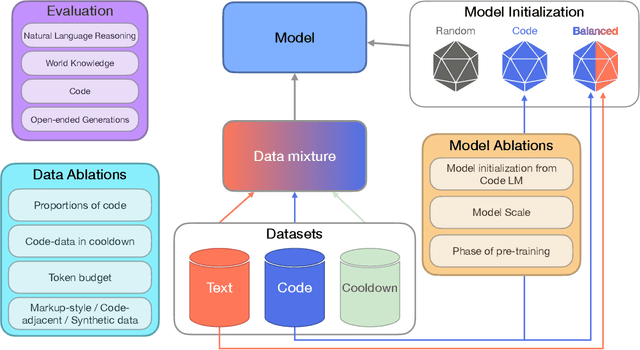
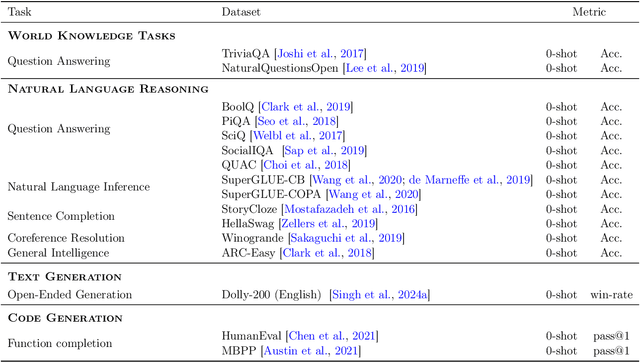
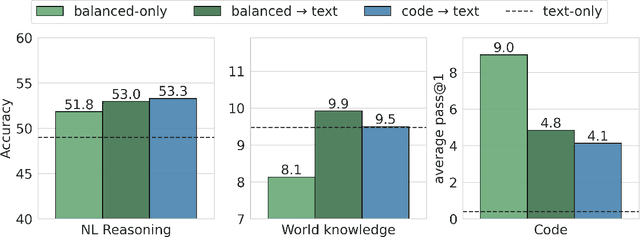
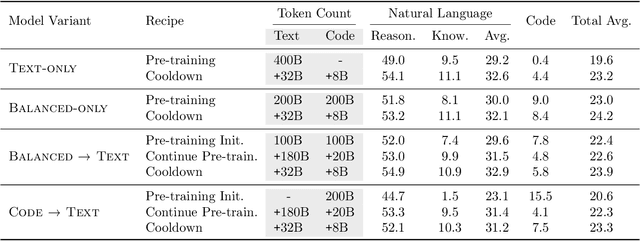
Abstract:Including code in the pre-training data mixture, even for models not specifically designed for code, has become a common practice in LLMs pre-training. While there has been anecdotal consensus among practitioners that code data plays a vital role in general LLMs' performance, there is only limited work analyzing the precise impact of code on non-code tasks. In this work, we systematically investigate the impact of code data on general performance. We ask "what is the impact of code data used in pre-training on a large variety of downstream tasks beyond code generation". We conduct extensive ablations and evaluate across a broad range of natural language reasoning tasks, world knowledge tasks, code benchmarks, and LLM-as-a-judge win-rates for models with sizes ranging from 470M to 2.8B parameters. Across settings, we find a consistent results that code is a critical building block for generalization far beyond coding tasks and improvements to code quality have an outsized impact across all tasks. In particular, compared to text-only pre-training, the addition of code results in up to relative increase of 8.2% in natural language (NL) reasoning, 4.2% in world knowledge, 6.6% improvement in generative win-rates, and a 12x boost in code performance respectively. Our work suggests investments in code quality and preserving code during pre-training have positive impacts.
How Does Quantization Affect Multilingual LLMs?
Jul 03, 2024Abstract:Quantization techniques are widely used to improve inference speed and deployment of large language models. While a wide body of work examines the impact of quantized LLMs on English tasks, none have examined the effect of quantization across languages. We conduct a thorough analysis of quantized multilingual LLMs, focusing on their performance across languages and at varying scales. We use automatic benchmarks, LLM-as-a-Judge methods, and human evaluation, finding that (1) harmful effects of quantization are apparent in human evaluation, and automatic metrics severely underestimate the detriment: a 1.7% average drop in Japanese across automatic tasks corresponds to a 16.0% drop reported by human evaluators on realistic prompts; (2) languages are disparately affected by quantization, with non-Latin script languages impacted worst; and (3) challenging tasks such as mathematical reasoning degrade fastest. As the ability to serve low-compute models is critical for wide global adoption of NLP technologies, our results urge consideration of multilingual performance as a key evaluation criterion for efficient models.
RLHF Can Speak Many Languages: Unlocking Multilingual Preference Optimization for LLMs
Jul 02, 2024Abstract:Preference optimization techniques have become a standard final stage for training state-of-art large language models (LLMs). However, despite widespread adoption, the vast majority of work to-date has focused on first-class citizen languages like English and Chinese. This captures a small fraction of the languages in the world, but also makes it unclear which aspects of current state-of-the-art research transfer to a multilingual setting. In this work, we perform an exhaustive study to achieve a new state-of-the-art in aligning multilingual LLMs. We introduce a novel, scalable method for generating high-quality multilingual feedback data to balance data coverage. We establish the benefits of cross-lingual transfer and increased dataset size in preference training. Our preference-trained model achieves a 54.4% win-rate against Aya 23 8B, the current state-of-the-art multilingual LLM in its parameter class, and a 69.5% win-rate or higher against widely used models like Gemma-1.1-7B-it, Llama-3-8B-Instruct, Mistral-7B-Instruct-v0.3. As a result of our study, we expand the frontier of alignment techniques to 23 languages covering half of the world's population.
Aya 23: Open Weight Releases to Further Multilingual Progress
May 23, 2024

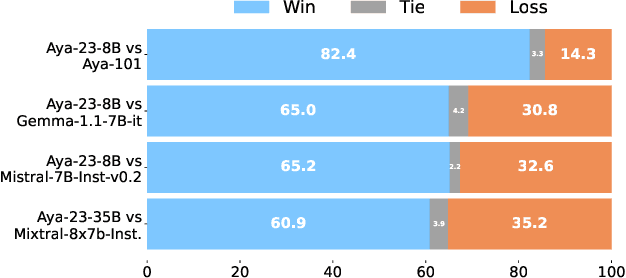

Abstract:This technical report introduces Aya 23, a family of multilingual language models. Aya 23 builds on the recent release of the Aya model (\"Ust\"un et al., 2024), focusing on pairing a highly performant pre-trained model with the recently released Aya collection (Singh et al., 2024). The result is a powerful multilingual large language model serving 23 languages, expanding state-of-art language modeling capabilities to approximately half of the world's population. The Aya model covered 101 languages whereas Aya 23 is an experiment in depth vs breadth, exploring the impact of allocating more capacity to fewer languages that are included during pre-training. Aya 23 outperforms both previous massively multilingual models like Aya 101 for the languages it covers, as well as widely used models like Gemma, Mistral and Mixtral on an extensive range of discriminative and generative tasks. We release the open weights for both the 8B and 35B models as part of our continued commitment for expanding access to multilingual progress.
Back to Basics: Revisiting REINFORCE Style Optimization for Learning from Human Feedback in LLMs
Feb 26, 2024Abstract:AI alignment in the shape of Reinforcement Learning from Human Feedback (RLHF) is increasingly treated as a crucial ingredient for high performance large language models. Proximal Policy Optimization (PPO) has been positioned by recent literature as the canonical method for the RL part of RLHF. However, it involves both high computational cost and sensitive hyperparameter tuning. We posit that most of the motivational principles that led to the development of PPO are less of a practical concern in RLHF and advocate for a less computationally expensive method that preserves and even increases performance. We revisit the formulation of alignment from human preferences in the context of RL. Keeping simplicity as a guiding principle, we show that many components of PPO are unnecessary in an RLHF context and that far simpler REINFORCE-style optimization variants outperform both PPO and newly proposed "RL-free" methods such as DPO and RAFT. Our work suggests that careful adaptation to LLMs alignment characteristics enables benefiting from online RL optimization at low cost.
 Add to Chrome
Add to Chrome Add to Firefox
Add to Firefox Add to Edge
Add to Edge